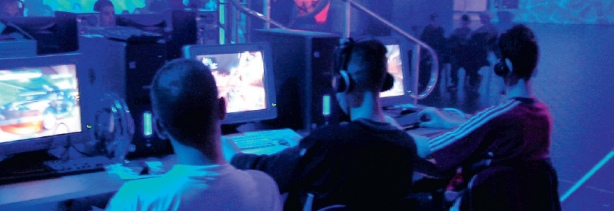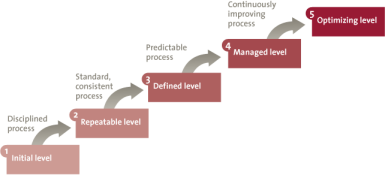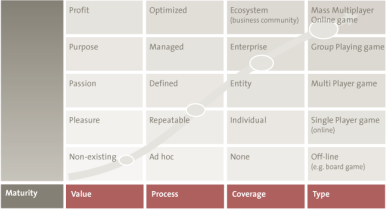1. Introduction
In organizations all over the world we see the growing importance of technology, the changing ways people interact and the need to constantly transform businesses giving rise to the use of gaming. At this moment the use of serious or applied games is still new for many organizations. The current market of applied gaming is estimated at $10 billion worldwide. Analysts predict that this market will boom. Within 5 years it could exceed the entertainment game market, which is estimated at $70 billion. Our forecast is that within 5 years the use and development of applied games will have a role in our daily lives and the way we do business that will be similar to the role social media has today. “By the age of 21, the average young American has spent somewhere between two and three thousand hours reading books and ten thousand hours on playing computer and video games” ([McGo11]). The younger generations are no longer learning and working in the same way as we do, through books. They are using gaming technology in many ways that drive this emerging market, and more than just playing games for fun and entertainment.
This article introduces the Game Maturity Model. In current markets, organizations continually face pressure to gain and retain competitive advantage, identify ways to cut costs, improve quality and reduce time to market. Gamification and a framework to help organizations build this capability can help them advance on these issues. We argue that gamification and maturity modeling can help organizations improve their businesses, hence we developed the Game Maturity Model. This Game Maturity Model can help organizations quickly determine their target position and develop a roadmap for moving from their current to their target position.
First, the meaning of the term “applied or serious games” is briefly discussed, after which the theory of maturity models is presented. Finally, this article shows the design of the Game Maturity Model and the way it can be used by organizations.
2. Applied games and gamification
Serious or applied games are models or simulations of real-world events or processes, designed for the purposes of problem-solving and learning. Although applied or serious games are entertaining, their main purpose, in our opinion, is to change the behavior of human beings and organizations (such as management, employees or consumers). For the purpose of this article we use the term “applied gaming” instead of serious gaming”. The reason for this is that, in our opinion, “serious gaming” is a contradiction in terms. “Serious” is seen by many of us as no fun at all. Fun is a characteristic in all games; what differs is how some games have serious applications. “Serious gaming” also implies that there are games that are not serious. This is not the case.
Applied games are very often used in the context of gamification. Gamification is the use of game mechanics and game design in non-game scenarios in order to increase participation and engagement. Typically, gamified processes and applications are developed in order to engage users to participate, share and interact in an activity or community. Gamification is a method to engage employees and customers (consumers) in desired behaviors, while using their involvement to solve problems. Essentially, it takes advantage of humans’ psychological predisposition to engage in gaming.
Gamification applications can have a wide variety of possible objectives, areas of application, complexity and levels of voluntariness, depending on the goal of the game. For instance internal gamification focuses on processes inside the organization, such as HR, training and compliance and regulations. Gamification focuses on finding fun in the things an employee has to do and in doing so to better involve them in serious subjects such as sustainability. Fun is a result of learning and learning is pattern recognition. By recognizing patterns, our brain produces endorphins and dopamine, and we experience ”fun”. External gamification focuses on things outside the organization, such as marketing-related gamification. The focus here is trying to enhance the customer and user experience. It is argued that the end goal of gamification is incorporating games into the ecosystem of the organization. There is also a difference in the application of gamification if you look at the complexity of the tasks the game addresses. This can be a very complex task, such as a game that helps surgeons practice surgeries, but it may also be related to more common tasks, such as compliance training. For both, gamification can be applied effectively.
Using games or applying game elements is not a new concept. Military officers have been using war games in order to train strategic skills for a long time. Also, there are a lot of games focused on policy and management issues. More focused sub-groups have appeared, including Games for Change which focuses on social issues and social change, and Games for Health which addresses health-care applications ([Wiki13]).
Current gamification applications often focus on training, sales-related activities, project management, employee reward and recognition programs, knowledge collaboration, innovation management, or marketing and customer interaction. There are very advanced forms of gamification that stretch our imagination. For example, there are games that aim at fighting cancer or changing the way we build cities. There are prominent gamification techniques such as achievement badges, achievement levels, leader boards, progress bars (indicating how far from the completing the task the user is), virtual currency, systems for awarding and exchanging, challenges between users, etc. ([Wiki13])
Table 1. Common gamification applications & techniques.
| Common Gamification Applications | Common Gamification Techniques |
|---|---|
| Training | Achievement badges |
| Sales | Achievement levels |
| Project management | Leader boards |
| Employee reward and recognition programs | Progress bars |
| Knowledge collaboration | Virtual currencies |
| Innovation management | System for awarding and exchanging |
| Marketing and customer interaction | Challenges between users |
3. Maturity modeling
A maturity model basically indicates what level an organization is at within a specific domain. “Maturity models are used as an evaluative and comparative basis for improvement in order to derive an informed approach for increasing capability of a specific domain within the organization” ([Brui05]). A maturity model evaluates an organization only in one specific domain and ranks an organization in one of the levels of maturity defined. The scope of a maturity model aims at the entity the model is focusing on. Often these are organizational entities.
As outlined, maturity models typically include a sequence of levels (or stages) that form an anticipated, desired, or logical path from an initial state to maturity. Basically, maturity models consist of several maturity levels or stages, with a typical evolutionary path through these stages. The first stage, normally called the bottom or initial stage, indicates an organization (or process) with few capabilities in the domain the model is covering. Low maturity can in general be described as un-coordinated, reactive, internally focused, low resourcing, naïve and static. In contrast, the highest stage represents an organization with total maturity in the specific domain. High maturity can be described as organization-wide focus, proactive innovation, efficient resourcing and comprehensive understanding. A maturity model functions as a scale for assessing an organization’s position on the evolution path. Often, these models provide characteristics that need to be in place for an organization to be described as being at a particular maturity level. A maturity model provides different characteristics for each specific level. In between the initial and mature phase are one or more growth phases. It is important that these phases logically follow.
In management, maturity models have proven to be a helpful instrument, because these models allow for better positioning of the organization and help to stimulate continuous improvement. A maturity model can help organizations in quickly assessing their current position and developing a roadmap for improving their domain position from the current to the desired level.
4. Maturity models and applied gaming
We saw that there was a need for a maturity model that focuses on the subject of applied gaming. In our opinion, the need for an adequate game maturity model is growing rapidly as organizations relentlessly step up the pace and size of investments in applied games. As a result, the dependence on reliable, continuous and competitive applied games is mounting. Our prediction is that within 5 years organizations will be coming under increasing pressure to achieve above-average performance using applied games. The various stakeholders (including top management, line managers, the HR manager, shareholders, suppliers and customers) insist on direct, increasingly transparent insight into whether applied games and the operationalization of those games yields added value without generating irresponsible investments.
In developing a maturity model, we compared the model with other relevant maturity models in terms of the pre-determined problem, target and demand. A good example of the concept of measuring maturity of an organization was introduced with the Capability Maturity Model (CMM) in 1991 by Carnegie Mellon University ([Team02]). This is a widely used model that focuses on the domain software development and maintenance of an organization. The model can indicate at what level the software development capability of an organization stands. The model distinguishes five levels: the initial, repeatable, defined, managed and optimizing levels.
Figure 1. Capability Maturity Model for Software Development ([Team02])
5. The Game Maturity Model
As outlined, gamification can have either or both an internal or external focus. An organization can implement several loose solutions to problems, or can integrate gamification into its corporate strategy. Games can focus on training or behavioral change. Each of these decisions will have an impact on the maturity of an organization in regards to gamification. We believe that maturity modeling can help identify were an organization stands with regards to gamification and help the organization identify steps to proceed to the next maturity level. For instance, gamification can be applied to make a work task more fun for employees, without necessarily achieving benefits like behavioral change or learning. This would indicate a lower level of maturity in comparison to an organization that implemented gamification in its organization while achieving these benefits, indicating that gamification contributes to the actual business execution.
The model distinguishes four perspectives, each with five maturity levels. We designed the model with five levels, because this is in line with the CMM model, which is the basis of many maturity models. The model distinguishes four perspectives. The four perspectives are related to, first, the value that is produced with gamification; second, the process that is in place in the organization to support the gamification strategy; third, the company-wide coverage that is applied to gamification, and, fourth, the technology that is used for gamification to be a success. We propose that organizations rank themselves on each of the four perspectives in order to assess the level of gamification and the contribution of gamification to their strategic goals.
Figure 2. The Game Maturity Model. [Click on the image for a larger image]
The first perspective of the model is related to the value generated through gamification.
Value:
- Non-existing – No value seen in using games, or no gamification in place.
- Pleasure – Using games for pleasure but not yet for results. Games have no real purpose.
- Passion – Games promote flow and engagement, stimulate learning and business simulation.
- Purpose – The goal is to advance and innovate using games. Actual business execution is done through gamified process.
- Profit – Business profit is made out of gamification.
The lowest level of value generated through gamification applies to organizations where there is no gamification. Organizations who do not use game techniques in their products or services would be scored in this level. The next level applies if games are used solely for pleasure, and not yet for actual business results. The effect is short-term and focused on getting a dopamine effect (a rush). These games would not have a real purpose (yet). This would be the case if an organization lets its employees or customers play a game just for entertainment, without expecting result out of this. In the next level, called “passion”, flow and engagement are central. An organization that is scored in this level uses game techniques to enhance their employees or consumers in a certain activity, empowering them to spend a lot of time on this activity they otherwise would not spend this much time on. An organization that uses gamification techniques for learning and business simulation would be scored in this level. It is argued that when people are in the state of “flow” they can concentrate on a subject for a long period and very intensively without distraction (Hsieh, 2010). Gamification techniques can enhance this state and can therefore help organizations to engage their customers or teach their employees. The fourth level, “purpose” would be applicable if there is a higher purpose to applying games. It is part of achieving something bigger than presently exists: for instance, applying games that relate to the strategic business goals: for instance, a hospital that uses game techniques to change the mindset of its employees or a game that can cure or save the lives of patients. The last maturity level, “profit,” describes game initiatives that actually succeed in meeting this higher purpose. You can measure and validate the outcome. This can be financial profit or non-monetary benefit: for example, improving the quality of life for a patient with Parkinson’s disease; or improving compliance with regulations in a financial institution thanks to behavioral change achieved by playing a “Compliance Game.”
The second perspective of the Game Maturity Model is related to the process that is in place to support gamification.
Process:
- Initial – Gamification processes are unpredictable, poorly controlled and reactive.
- Repeatable – Processes are matched to projects and are often reactive.
- Defined – Gamification processes are developed organization-wide and are proactive.
- Managed – The gamification process is measured and controlled.
- Optimized – There is a focus on continuous monitoring and improvement.
The evolutionary path that goes through the levels of the perspective process is adopted from the CMM model ([Team02]). The difference is that the Game Maturity Model only focuses on the processes in place to support gamification. In the “initial” level, gamification processes are unpredictable, poorly controlled and reactive. Problems in the game processes are only solved after they appear. In the repeatable level, processes for gamification projects are developed, but the organization still acts reactively towards gamification. It is an improvement over the lower level in that knowledge already gained will not be lost through the project management capability that is developed. In the “defined” level, an organization starts to act proactively towards gamification processes. Gamification processes are well-known throughout the organization. In the fourth level, the gamification processes are structured as part of the management function, so the outcomes of gamification initiatives are measured and controlled. In the highest level of this perspective, “optimized” processes around gamification are organized, managed and well-known. The focus has shifted towards continuous improvements by empowering employees of an organization to generate long-term benefits through applying processes around gamification.
The third perspective of the model is related to coverage, or the ways in which gamification and games are applied by organizations.
Coverage:
- None – No gamification in place
- Individuals – Gamification is applied by individuals
- Entity – Gamification is applied within functional groups or business units
- Enterprise – Gamification is applied on an enterprise level interaction
- Ecosystem – Gamification is applied in complete horizontal and vertical integration with the ecosystem of the organization
At the initial level of this perspective, gamification is non-existing. The second level indicates that some individuals within the organization apply gaming techniques, but there is no wide implementation of games throughout the organization. The next level, “entity,” indicates that games are used on the group or business unit level. Currently, you often see that human resource and marketing departments are the early adopters of gamification techniques. For instance, a human resources department may use games to support their online training program, or a marketing department may use game techniques to involve customers. An example of this is Starbucks, which offers a mobile app having a rewards section in which game elements are embedded ([Star13]). In such a case gamification has been applied by the marketing department, but it may not have spread throughout other parts of the organization. At the fourth level, the application of games is spread throughout the whole organization. Gamification is an important topic on the board level, and is used in many different ways (e.g., education and training purposes, product development and business transformation). The highest level is where the whole ecosystem of an organization is involved in the application of games. Not only employees of the firm itself, but also customers, suppliers and other stakeholders are involved in game techniques. Gamification is applied externally. An example is the airline KLM, which involves customers of their loyalty program in optimizing their company processes through playing games. The game is called Aviation Empire ([KLM13]).
The fourth perspective of the model is related to the different types of games that are used by organizations.
Type:
- Off-line – Non-internet, non-network components, such as traditional board games, are used.
- Single-player – Online single-player techniques are used.
- Multi-player – Online multi-player techniques are used.
- Group-playing – Online group playing techniques are used.
- MMO – Massive multi-player techniques are used.
There are many types of games and many ways to categorize them. We have chosen the types described above as benchmarks for this categorization because they chart an evolutionary development. As the levels rise, techniques enable the game to be played by more and more users. In the first level, traditional off-line games are played within an organization. In many cases these are traditional board games. An organization at this level sees the benefits of games and therefore plays games, but does not have the technology in-house to support this. Board games or paper-based games (e.g., traditional management games) are played off-line and without the use of technology. It is important to mention that there is nothing wrong with a board game or any other off-line game. These kinds of games have proven to be very effective, and they are still effective in many ways. In the maturity model our focus is on on-line games. In the next level “Single-player” games are online and realized through the use of technology. In this level an organization uses online single-player techniques to support its gamification strategy. A single-player game is a game where input from only one player is expected and no collaboration between other players is in place, as there are no others players who play the game in the same environment. In the next level of maturity, an organization would use multi-player game techniques. A multi-player game is designed to let more than one player play in the same game environment at the same time. Other players in the game are real-life people: for instance, colleagues. This enhances interaction between the players of the game. Interaction could be in the form of partnerships, competition or collaboration. All are relevant if you look at the real-life situation an organization and its employees are in daily. Such a multi-player game can help an organization understand the social context in which situations happen. The fourth level is a type of group game: specific groups of people are playing the game together in an on-line environment. The Dutch ministry of Defence, for example, is using this kind of game to train groups of a hundred or more soldiers to prepare them for their international missions. The highest level of maturity is applicable when we talk about massive multi-player online games. This are very often web browser or console based, in which a very large number of players interact with one another within a virtual game world. The most famous and popular pure entertainment MMO-RPG game is World of Warcraft, with more than 8 million players. In a MMO game the players are all real people who interact in the online game environment. Massive multi-player online games are distinguished from single player and multi-player games by the number of players. When the player is offline the game environment still exists, and it evolves as other game players continue to play in the online environment. The development of a MMO-game
is very time-consuming and, in many cases, expensive. Massive multi-player online games are building the ultimate collaboration. They can also generate insights by making use of the behaviors of real-life people who play the game. Such a game can, for instance, be used to test a new marketing campaign or supply-chain strategy in detail across the globe. This type of game enables organizations to experiment with new strategies in a close-to-real-life setting. Promoting collaboration can result in new and innovative solutions to problems. “Very big games represent the future of collaboration. They are the best solution we have for solving the most complex problems of our time. They are giving more people than ever before in human history the opportunity to do work that really matters, and to participate directly in changing the whole world ([McGo11]).”
6. Case studies
There are many examples of applied games. For the sake of this article we have picked two examples to demonstrate the strength of the Game Maturity Model:
Table 2. Two examples of the strength of the Gaming Maturity Model.
| KLM Aviation Empire (2013) | Royal Dutch Ground Forces (2013) | |
|---|---|---|
| Perspective | In this game players can build their online airline company and manage the organization. | The Royal Dutch Ground Forces are using different games in which military officers can practice close-to-real-life situations in a virtual war zone. Drills and procedures can be practiced through the game. |
| Value | The game is ranked in the category “purpose.” Not only is this game fun to play for the customers of KLM, it also contributes to process innovation and customer loyalty. In the game players can design airline processes themselves. New and innovative ideas on the design of the processes can be extracted from the game. | The game is ranked in the category “profit.” The game helps soldiers and officers to experience what it is to be in combat. Because the game is more intuitive than learning from a book, players get in a flow state and learn the procedures faster, and are able to recall the training better in real-life situations. There is real profit. The cost savings are measured, but a non-monetary benefit is that it can improve reaction time in a combat situation. Therefore it could save lives. |
| Process | The internal processes in place inside the KLM organization to support these games are not known. | There is a real gamification process in place. The organization uses real maps and visuals from areas that they have to secure. A process is in place to keep these maps up to date and protocols are in place to adapt the game to a real live situation. Even though we are not fully aware of the processes designed inside the organization to support these games, we assume the Royal Dutch Ground Forces can be ranked within the category “managed.” |
| Coverage | The game is ranked in the category “ecosystem.” The game is used by the marketing department of KLM to enhance customer interaction with the company. Furthermore, other departments involved in airline processes will benefit from the game as outcomes of the game can positively effect processes within the organization. Because the game is played by consumers, the game focuses on the ecosystem around KLM. We understand that the game does not yet incorporate suppliers or other business partners. | The games are applied throughout the whole organization. As we know, the games are used for the Royal Dutch Ground Forces, and they are not played by other stakeholders or embedded into its environment, which could, for instance include other ground forces of co-operating countries. So we rank it within the category “enterprise.” |
| Type | The game uses single-player techniques and some multi-player features. Each player plays the game in an isolated environment and is not affected by decisions of other players. It would be interesting to see if the game would translate to a multi-player game, as then the interactions between users would become visible. | The game uses group playing techniques. Military offices can train multiple individuals for a specific situation together in the same environment, which enables collaboration. This technique shows behavior of different users and makes it possible for officers to act on the behavior of their colleagues. |
7. Conclusion
In implementing games in a business environment, the Game Maturity Model proves to be an excellent management tool as it links the vision and a strategy of organizations into concrete objectives for gamification. In our opinion these objectives must be organized along the lines of the four different perspectives: the value perspective, the process perspective, the coverage perspective and the technology perspective.
The essence of the vision of applying games in organizations is that the growth in maturity in practice takes place on the basis of different calculated steps. For determining these steps, the maturity of the organization plays an important role. As an organization becomes more mature, the maturity levels go up and a better equilibrium is established between the different perspectives. In addition, the relationship with the organisation as a whole becomes clear.
During the first growth level, gamification is managed in the short-term and mostly by individual front runners. In the second and third levels, more emphasis is placed on the strategy of how to apply games as an organization. The focus, however, will be internally driven. The relationships between the different perspectives (value, process, coverage and technology) are not in place in the lower levels. In level four, the focus on the different perspectives is tight and predominantly externally driven. In level five, there is a genuine balance between the different perspectives, with the cause-and-effect relationships being included in management on a structural basis. Also, there are safeguards to ensure that the Game Maturity Levels are linking up to the business strategy and to the ecosystem of the organization as a whole.
Practice has shown that the maturity of an organization is indeed a determining factor for the way in which gamification develops. It can provide good support to managers to make more insightful and better decisions for achieving strategic objectives.
To conclude this article, we would like to list a number of dos and don’ts in the implementation of the Game Maturity Model:
Table 3. Do’s and Don’ts at the implementation of the Gaming Maturity Model.
| Implementation Game Maturity Model: Dos | Implementation Game Maturity Model: Don’ts |
|---|---|
|
|
|
|
|
|
It will be clear to the reader that applying games in a business context is not a one-off event. We believe that the Game Maturity Model can be genuinely used as a start and as a model for ongoing reference. We truly believe that companies can no longer afford to see games as an activity that we do in our spare time or that is something for kids. Games are dominant in our real lives and they can lead us in many cases to new forms of collaboration and innovation. As mentioned in the book: Reality is Broken, How Games Make Us Better and How They Can Change the World, the real challenge for us today is how to integrate games more closely into our everday lives, and how to embrace them as a platform for collaboration on our most important efforts. We as authors of this article believe that business opportunities for organizations are immense, and that now is the time to take applied games seriously.
Literature
[Brui05] De Bruin, T., Freeze, R, Kulkarni, U. & Rosemann, M. (2005). “Understanding the Main Phases of Developing a Maturity Assessment Model.” ACIS 2005 Proceedings, Paper 109.
[Coon85] Coonradt, Ch. & Nelson, L. (1985). The Game of Work: How to Enjoy Work as Much as Play (1st ed.). Deseret Book.
[Defe13] Defensie (2013). http://www.defensie.nl/actueel/nieuws/2013/04/12/46204671/Wereldwijde_training_via_Serious_Gaming.
[Hsie10] Hsieh, T. (2010). Delivering Happiness: A Path to Profits, Passion, and Purpose. New York: Business Plus.
[KLM13] KLM (2013). “The KLM Game.” http://game.klm.com/.
[Lee07] Lee, J., Lee, D., & Kang, S. (2007). “An Overview of the Business Process Maturity Model (BPMM). In Advances in Web and Network Technologies, and Information Management.” Pp. 384-395. Springer Berlin Heidelberg.
[McGo11] McGonigal, J. (2011). Reality is Broken: Why Games Make Us Better and How They Can Change the World. New York: Penguin Press.
[PWC13] PWC, Global entertainment and media outlook 2013.
[Reev09] Reeves, B., Leighton Read, J. (2009). Total Engagement: Using Games and Virtual Worlds to Change the Way People Work and Businesses Compete. Harvard Business Press.
[Star13] MyStarbucks (app) (2013). Starbucks, http://www.starbucks.com/coffeehouse/mobile-apps/mystarbucks
[Team02] Team, C. P. (2002). Capability Maturity Model® Integration (CMMI SM), Version 1.1. Software Engineering Institute, Carnegie Mellon University/SEI-2002-TR-012. Pittsburg, PA.
[Wiki13] Wikipedia (2013). “Gamification.” http://en.wikipedia.org/wiki/Gamification







